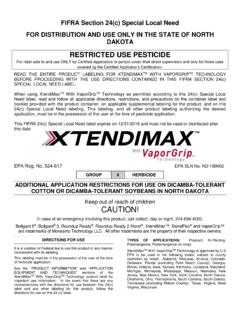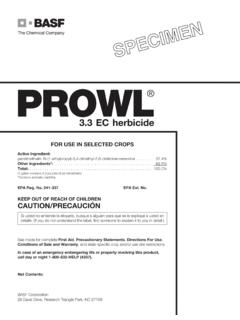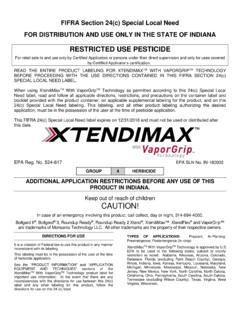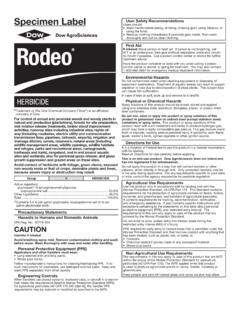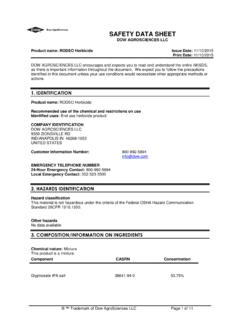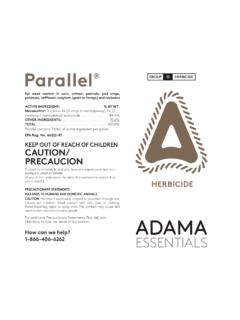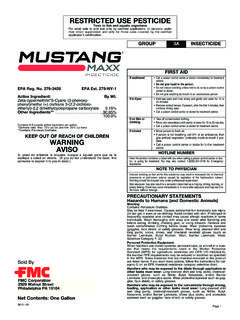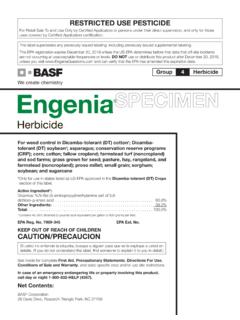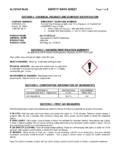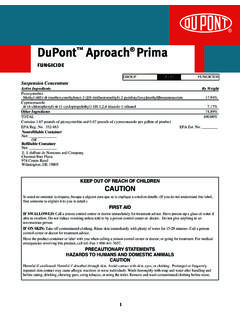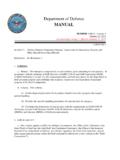Transcription of TENKOZ LO-VOL 4 2,4-D LOW VOLATILE HERBICIDE
1 SAFETY DATA SHEET TENKOZ LO-VOL 4 TENKOZ , Inc. 1. CHEMICAL PRODUCT AND COMPANY IDENTIFICATION Product Name: TENKOZ LO-VOL 4 2,4-D LOW VOLATILE HERBICIDE EPA Reg. No.: 228-139-55467 Product Type: HERBICIDE Company Name: TENKOZ , Inc. 1725 Windward Concourse, Suite 410 Alpharetta, GA 30005 770-343-8509 Telephone Numbers: For Chemical Emergency, Spill, Leak, Fire, Exposure, or Accident, Call CHEMTREC Day or Night: 1-800-424-9300 For Medical Emergencies Only, Call 1-877-325-1840 This product is an EPA FIFRA registered pesticide. Some classifications on this SDS are not the same as the FIFRA label. Certain sections of this SDS are superseded by federal law governed by EPA for a registered pesticide.
2 Please see Section 15. REGULATORY INFORMATION for explanation. 2. HAZARDS IDENTIFICATION PHYSICAL HAZARDS: Not Hazardous HEALTH HAZARDS: Acute toxicity, oral Category 4 Aspiration Hazard Category 1 ENVIRONMENTAL HAZARDS: Hazardous to aquatic environment, acute Category 1 Hazardous to aquatic environment, chronic Category 1 SIGNAL WORD: DANGER HAZARD STATEMENTS: Harmful if swallowed. May be fatal if swallowed and enters airway. Very toxic to aquatic life with long lasting effects. PRECAUTIONARY STATEMENTS Wash hands thoroughly after handling. Do not eat, drink or smoke when using this product. Avoid release to the environment.
3 IF SWALLOWED: call a POISON CENTER or doctor. Do not induce vomiting. Rinse mouth. Collect Spillage. Store locked up. Dispose of contents in accordance with local, state, and federal regulations 3. COMPOSITION / INFORMATION ON INGREDIENTS COMPONENTS CAS NO. % BY WEIGHT 2,4-D Ethylhexyl Ester 1928-43-4 70 Distillates (Petroleum), Hydrotreated Light 64742-47-8 Other ingredients Trade Secret Trade Secret Synonyms: 2,4-D 2 EHE; 2,4-D IOE; 2,4-Dichlorophenoxyacetic acid, Isooctyl (2-ethylhexyl ester); 2,4-D Ethylhexyl Ester Ingredients not precisely identified are proprietary or non-hazardous. Values are not product specifications. 4.
4 FIRST AID MEASURES March 20, 2015 Page 1 of 7 SAFETY DATA SHEET TENKOZ LO-VOL 4 If Swallowed: Call a poison control center or doctor immediately for treatment advice. Do not induce vomiting. Do not give anything by mouth to an unconscious person. If on Skin or Clothing: Take off contaminated clothing. Wash with soap and water. Call a poison control center or doctor for treatment advice. If in Eyes: Hold eye open and rinse slowly and gently with water for several minutes. Remove contact lenses, if present, after the first 5 minutes, then continue rinsing eye. Call a poison control center or doctor for treatment advice.
5 If Inhaled: Move person to fresh air. If person is not breathing, call 911 or an ambulance, then give artificial respiration, preferably by mouth-to-mouth, if possible. Call a poison control center or doctor for further treatment advice. Note to Physician: Contains a petroleum distillate. Vomiting may cause aspiration pneumonia. Most Important symptoms/effects, acute and delayed: May cause eye and skin irritation. Inhalation of vapors may cause respiratory irritation and headache, dizziness and drowsiness. Aspiration hazard. If swallowed, may enter the lungs to cause serious lung damage which can be fatal. Indication of Immediate medical attention and special treatment if needed: Immediate medical attention is required for ingestion.
6 For ingestion there is no specific antidote available. Treat symptomatically. 5. FIRE FIGHTING MEASURES Extinguishing Media: Recommended for large fires: foam or water spray. Recommended for small fires: dry chemical or carbon dioxide. Special Fire Fighting Procedures: Firefighters should wear NIOSH approved self-contained breathing apparatus and full fire-fighting turn out gear. Dike area to prevent runoff and contamination of water sources. Dispose of fire control water later. Unusual Fire and Explosion Hazards: If water is used to fight fire, contain runoff, using dikes to prevent contamination of water supplies.
7 Dispose of fire control water later. Hazardous Decomposition Materials (Under Fire Conditions): May produce gases such as hydrogen chloride and oxides of carbon and nitrogen. 6. ACCIDENTAL RELEASE MEASURES Personal Precautions: Wear appropriate protective gear for the situation. See Personal Protection information in Section 8. Environmental Precautions: Prevent material from entering public sewer systems or any waterways. Do not flush to drain. Large spills to soil or similar surfaces may necessitate removal of topsoil. The affected area should be removed and placed in an appropriate container for disposal. Methods for Containment: Dike spill using absorbent or impervious materials such as earth, sand or clay.
8 Collect and contain contaminated absorbent and dike material for disposal. Methods for Cleanup and Disposal: Pump any free liquid into an appropriate closed container. Collect washings for disposal. Decontaminate tools and equipment following cleanup. See Section 13: DISPOSAL CONSIDERATIONS for more information. Other Information: Large spills may be reportable to the National Response Center (800-424-8802) and to state and/or local agencies 7. HANDLING AND STORAGE HANDLING: Avoid contact with skin, eyes and clothing. Users should wash hands before eating, drinking, chewing gum, using tobacco or using the toilet.
9 Remove clothing\Personal Protective Equipment (PPE) immediately if pesticide gets inside. Then wash thoroughly and put on clean clothing. If pesticide gets on skin, wash immediately with soap and water. Remove PPE immediately after handling this product. Wash outside of gloves before removing. As soon as possible, wash thoroughly and change into clean clothing. STORAGE: Always use original container to store pesticides in a secured warehouse or storage building. Containers should be opened in well-ventilated areas. Keep container tightly sealed when not in use. Do not stack cardboard cases more than two pallets high.
10 Do not store near open containers of fertilizer, seed or other pesticides. Do not contaminate water, food, or feed by storage or disposal. 8. EXPOSURE CONTROLS / PERSONAL PROTECTION March 20, 2015 Page 2 of 7 SAFETY DATA SHEET TENKOZ LO-VOL 4 Engineering Controls: Where engineering controls are indicated by specific use conditions or a potential for excessive exposure, use local exhaust ventilation at the point of generation. Personal Protective Equipment: Eye/Face Protection: To avoid contact with eyes, wear chemical goggles. Skin Protection: To avoid contact with skin, wear long pants, long-sleeved shirt, socks, shoes and chemical-resistant gloves.
